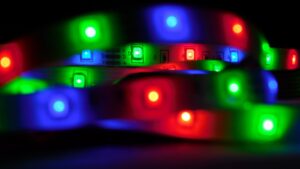How Do LEDs Actually Work?
Posted by Emma Reid on 19th Apr 2022

We’ve talked a lot about all the amazing advantages that come from using LED bulbs over other methods of lighting…but how do they actually work?
LEDs are efficient, durable, long-lasting and amazing value for money. A major reason for these benefits comes down to the fundamentals of how an LED is built. Let’s take a quick and simple look at how an LED works and what sets them apart from other bulbs.
How Do They Work?
LED stands for Light Emitting Diode. These diodes are tiny semi-conductors (which is a material that can have a variable ability to conduct electrical currents) that emit light when a current passes through it. Think of them like tiny light bulbs that can be easily fitted into an electric circuit.
These microchips produce visible light with minimal wastage, resulting in a method of lighting that boasts a 90% efficiency rate. A 6-watt halogen bulb will produce an equivalent number of lumens as a 60w halogen as a result.
It also means they can be very compact, which is why you’ll see them used in a range of practical applications, including flat screen LCD TVs and unusually shaped light fittings.
This also makes LEDs a lot more durable, and helps them to last for a really long time!
How Are They Different?
An incandescent bulb produces light by heating a filament to such a point that they start to glow, generating light. This is called incandescing! This is massively inefficient, as it results in nearly 90% of the energy is wasted on heat, rather than producing light. It’s also a lot less safe, hot bulbs are a fire risk!
A halogen bulb works in much the same way, but with slightly more advanced technology results in slightly improved efficiency. Still, there’s a reason these are being phased out in favour of LED bulbs.
CFLs are an alternative source of lighting that’s a little bit more efficient than incandescent bulbs. In these lights, an electric current flows between electrodes through a tube containing gases- most commonly mercury vapour. This is relatively efficient, but should your bulb break, then this can be very dangerous for your health. They’re also hard to dispose of in a green manner.
There are a few other quirks that come from the unique construction of LED bulbs.
LEDs are directional light sources, which simply means they emit light in a specific direction. This makes them a great choice for targeted lighting, as they can produce a more direct beam of light with less radiant illumination.
However, as the technology advances, you’ll find more and more LED bulbs that can produce lighting that closely mimics the lighting effects that you get with older bulbs. Look for bulbs with larger diffusers and wider beam angles.
LEDs can also produce light in a range of colours and colour temperatures much more easily, because their chips can be ‘programmed’ to produce different colours. This is why you can get LEDs with RGB potential, which makes them a very popular option in smart homes!
Get In Touch
If you’ve got any more questions, then don’t hesitate to get in touch with us on 0116 321 4120 or send an email to cs@wled.co.uk.
You can also follow us on YouTube, Twitter, Instagram or Facebook.





